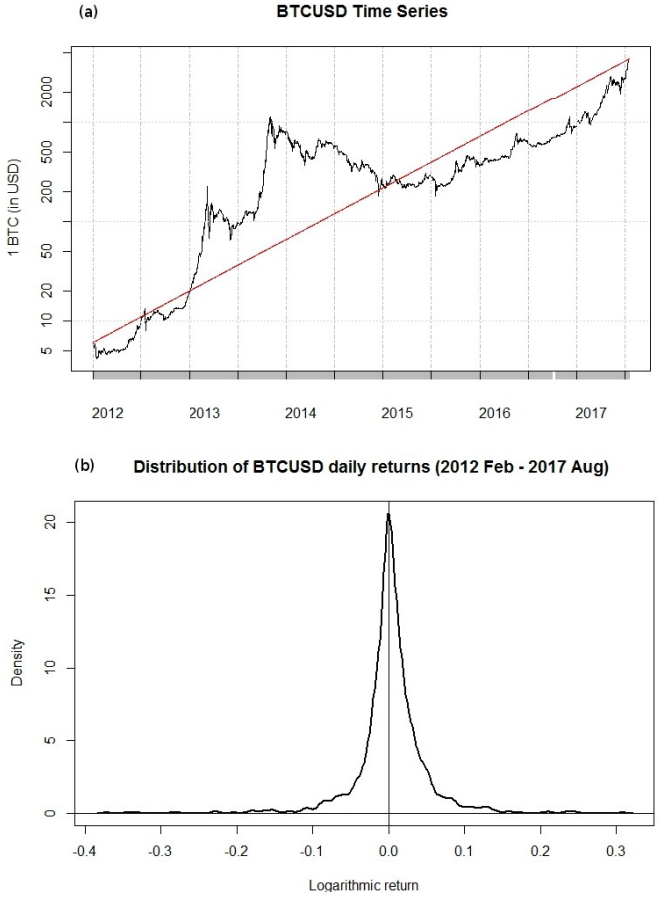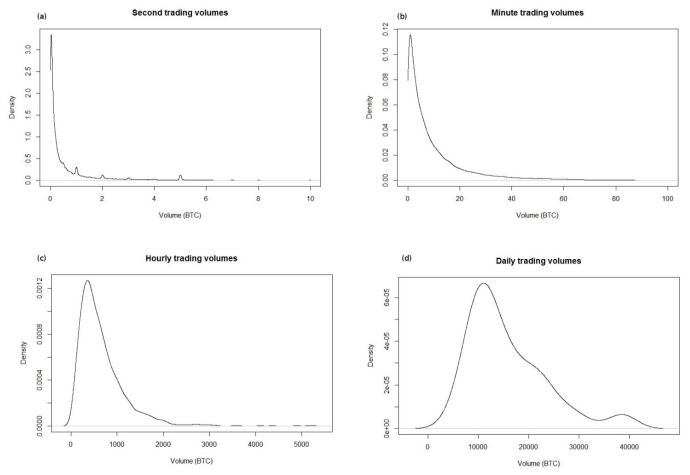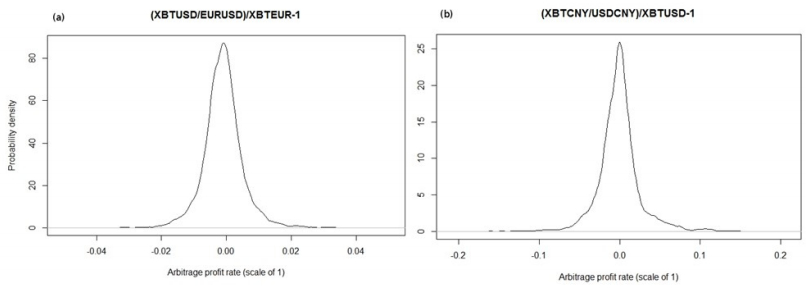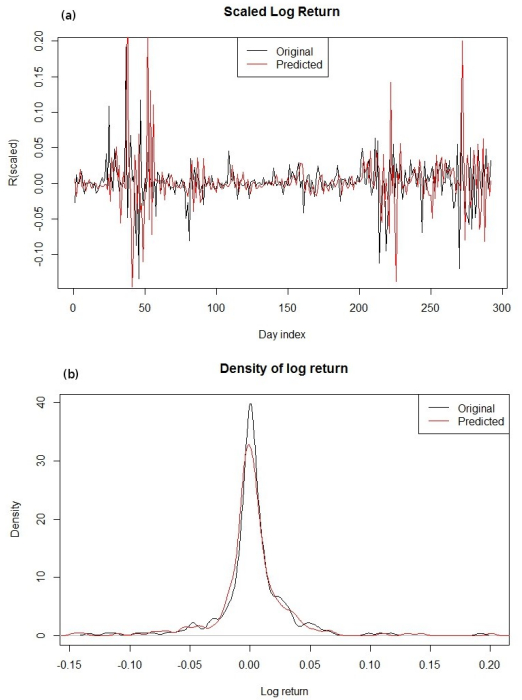| 1.
|
Rongda Chen, Huiwen Chen, Chenglu Jin, Bo Wei, Lean Yu,
Linkages and Spillovers between Internet Finance and Traditional Finance: Evidence from China,
2020,
56,
1540-496X,
1196,
10.1080/1540496X.2019.1658069
|
|
| 2.
|
Constandina Koki, Stefanos Leonardos, Georgios Piliouras,
Do Cryptocurrency Prices Camouflage Latent Economic Effects? A Bayesian Hidden Markov Approach,
2020,
12,
1999-5903,
59,
10.3390/fi12030059
|
|
| 3.
|
Mawuli Segnon, Stelios Bekiros,
Forecasting volatility in bitcoin market,
2020,
16,
1614-2446,
435,
10.1007/s10436-020-00368-y
|
|
| 4.
|
Zhenghui Li, Hao Dong, Zhehao Huang, Pierre Failler,
Asymmetric Effects on Risks of Virtual Financial Assets (VFAs) in different regimes: A Case of Bitcoin,
2018,
2,
2573-0134,
860,
10.3934/QFE.2018.4.860
|
|
| 5.
|
Nazan ŞAK,
Kripto Paralar Arasındaki İlişkinin İncelenmesi: Hatemi-J Asimetrik Nedensellik Analizi,
2021,
1308-9552,
149,
10.21076/vizyoner.753201
|
|
| 6.
|
Au Vo, Christopher Yost-Bremm,
A High-Frequency Algorithmic Trading Strategy for Cryptocurrency,
2020,
60,
0887-4417,
555,
10.1080/08874417.2018.1552090
|
|
| 7.
|
Jérémy Robert, Sylvain Kubler, Sankalp Ghatpande,
Enhanced Lightning Network (off-chain)-based micropayment in IoT ecosystems,
2020,
112,
0167739X,
283,
10.1016/j.future.2020.05.033
|
|
| 8.
|
Carlos CCsar Truccos Maza,
Forecasting Bitcoin Risk Measures: A Robust Approach,
2018,
1556-5068,
10.2139/ssrn.3189446
|
|
| 9.
|
Andrea Bucci,
Realized Volatility Forecasting with Neural Networks,
2020,
18,
1479-8409,
502,
10.1093/jjfinec/nbaa008
|
|
| 10.
|
M. Kamisli, S. Kamisli, F. Temizel,
2019,
Chapter 15,
978-3-030-25274-8,
293,
10.1007/978-3-030-25275-5_15
|
|
| 11.
|
Carlos Trucíos,
Forecasting Bitcoin risk measures: A robust approach,
2019,
35,
01692070,
836,
10.1016/j.ijforecast.2019.01.003
|
|
| 12.
|
Anoop S. Kumar, S. Anandarao,
Volatility spillover in crypto-currency markets: Some evidences from GARCH and wavelet analysis,
2019,
524,
03784371,
448,
10.1016/j.physa.2019.04.154
|
|
| 13.
|
Alisa Kim, Simon Trimborn, Wolfgang K. Härdle,
VCRIX - A Volatility Index for Crypto-Currencies,
2019,
1556-5068,
10.2139/ssrn.3480348
|
|
| 14.
|
Zheng Nan, Taisei Kaizoji,
Bitcoin-based triangular arbitrage with the Euro/U.S. dollar as a foreign futures hedge: modeling with a bivariate GARCH model,
2019,
3,
2573-0134,
347,
10.3934/QFE.2019.2.347
|
|
| 15.
|
Chuanhai Zhang, Huan Ma,
Futures-Trading Activity and Jump Risk: Evidence From the Bitcoin Market,
2020,
1556-5068,
10.2139/ssrn.3729476
|
|
| 16.
|
Sangjin Park, Kwahngsoo Jang, Jae-Suk Yang,
Information flow between bitcoin and other financial assets,
2021,
566,
03784371,
125604,
10.1016/j.physa.2020.125604
|
|
| 17.
|
Livea Rose Paul, Lipsa Sadath,
2021,
Big Data- Forecasting Digital Currency with R,
978-1-6654-1451-7,
286,
10.1109/Confluence51648.2021.9377153
|
|
| 18.
|
Chuanhai Zhang,
Testing for Self-exciting Jumps in Bitcoin Returns,
2020,
1556-5068,
10.2139/ssrn.3686237
|
|
| 19.
|
Parthajit Kayal, G. Balasubramanian,
Excess Volatility in Bitcoin: Extreme Value Volatility Estimation,
2021,
2277-9752,
227797522098768,
10.1177/2277975220987686
|
|
| 20.
|
Imlak Shaikh,
Policy uncertainty and Bitcoin returns,
2020,
20,
22148450,
257,
10.1016/j.bir.2020.02.003
|
|
| 21.
|
J. C. Gerlach, G. Demos, D. Sornette,
Dissection of Bitcoin’s multiscale bubble history from January 2012 to February 2018,
2019,
6,
2054-5703,
180643,
10.1098/rsos.180643
|
|
| 22.
|
Jan-Christian Gerlach, Guilherme Demos, Didier Sornette,
Dissection of Bitcoin's Multiscale Bubble History,
2018,
1556-5068,
10.2139/ssrn.3164246
|
|
| 23.
|
Aniruddha Dutta, Saket Kumar, Meheli Basu,
A Gated Recurrent Unit Approach to Bitcoin Price Prediction,
2020,
13,
1911-8074,
23,
10.3390/jrfm13020023
|
|
| 24.
|
Se-Hyun Ji, Ui-Jun Baek, Mu-Gon Shin, Young-Hoon Goo, Jun-Sang Park, Myung-Sup Kim,
2019,
Best Feature Selection using Correlation Analysis for Prediction of Bitcoin Transaction Count,
978-4-88552-320-5,
1,
10.23919/APNOMS.2019.8892896
|
|
| 25.
|
Divya Aggarwal, Shabana Chandrasekaran, Balamurugan Annamalai,
A complete empirical ensemble mode decomposition and support vector machine-based approach to predict Bitcoin prices,
2020,
27,
22146350,
100335,
10.1016/j.jbef.2020.100335
|
|
| 26.
|
Werner Kristjanpoller, Marcel C. Minutolo,
A hybrid volatility forecasting framework integrating GARCH, artificial neural network, technical analysis and principal components analysis,
2018,
109,
09574174,
1,
10.1016/j.eswa.2018.05.011
|
|
| 27.
|
Ke Wu, Spencer Wheatley, Didier Sornette,
Classification of cryptocurrency coins and tokens by the dynamics of their market capitalizations,
2018,
5,
2054-5703,
180381,
10.1098/rsos.180381
|
|
| 28.
|
Dean Fantazzini, Stephan Zimin,
A multivariate approach for the simultaneous modelling of market risk and credit risk for cryptocurrencies,
2020,
47,
0391-2078,
19,
10.1007/s40812-019-00136-8
|
|
| 29.
|
Hao Dong, Liming Chen, Xinyi Zhang, Pierre Failler, Sa Xu,
The Asymmetric Effect of Volatility Spillover in Global Virtual Financial Asset Markets: The Case of Bitcoin,
2020,
56,
1540-496X,
1293,
10.1080/1540496X.2019.1671819
|
|
| 30.
|
Shakshi Sharma, Rajesh Sharma,
2020,
Forecasting Transactional Amount in Bitcoin Network Using Temporal GNN Approach,
978-1-7281-1056-1,
478,
10.1109/ASONAM49781.2020.9381363
|
|
| 31.
|
Au Vo, Thomas A. Chapman, Yen-Sheng Lee,
Examining Bitcoin and Economic Determinants: An Evolutionary Perspective,
2021,
0887-4417,
1,
10.1080/08874417.2020.1865851
|
|
| 32.
|
Noshaba Zulfiqar, Saqib Gulzar,
Implied volatility estimation of bitcoin options and the stylized facts of option pricing,
2021,
7,
2199-4730,
10.1186/s40854-021-00280-y
|
|
| 33.
|
Ladislav Kristoufek,
Will Bitcoin ever become less volatile?,
2023,
51,
15446123,
103353,
10.1016/j.frl.2022.103353
|
|
| 34.
|
Chao Liang, Yaojie Zhang, Xiafei Li, Feng Ma,
Which predictor is more predictive for Bitcoin volatility? And why?,
2022,
27,
1076-9307,
1947,
10.1002/ijfe.2252
|
|
| 35.
|
Sahar Erfanian, Yewang Zhou, Amar Razzaq, Azhar Abbas, Asif Ali Safeer, Teng Li,
Predicting Bitcoin (BTC) Price in the Context of Economic Theories: A Machine Learning Approach,
2022,
24,
1099-4300,
1487,
10.3390/e24101487
|
|
| 36.
|
Yong Qi, Hefeifei Jiang, Shaoxuan Li, Junyu Cao,
ConvLSTM Coupled Economics Indicators Quantitative Trading Decision Model,
2022,
14,
2073-8994,
1896,
10.3390/sym14091896
|
|
| 37.
|
Isabela Ruiz Roque da Silva, Eli Hadad Junior, Pedro Paulo Balbi,
Cryptocurrencies trading algorithms: A review,
2022,
41,
0277-6693,
1661,
10.1002/for.2886
|
|
| 38.
|
Savva Shanaev, Mikhail Vasenin, Roman Stepanov,
Turn-of-the-candle effect in bitcoin returns,
2023,
24058440,
e14236,
10.1016/j.heliyon.2023.e14236
|
|
| 39.
|
Sang-Ha Sung, Jong-Min Kim, Byung-Kwon Park, Sangjin Kim,
A Study on Cryptocurrency Log-Return Price Prediction Using Multivariate Time-Series Model,
2022,
11,
2075-1680,
448,
10.3390/axioms11090448
|
|
| 40.
|
Alisa Kim, Simon Trimborn, Wolfgang Karl Härdle,
VCRIX — A volatility index for crypto-currencies,
2021,
78,
10575219,
101915,
10.1016/j.irfa.2021.101915
|
|
| 41.
|
Rizky Parlika, Arista Pratama,
Use of the Web API as a basis for obtaining the latest data on bitcoin prices at 30 exchange places,
2021,
1125,
1757-8981,
012035,
10.1088/1757-899X/1125/1/012035
|
|
| 42.
|
Sumaiya Begum Akbar, Kalaiselvi Thanupillai, Valarmathi Govindarajan,
Forecasting Bitcoin price using time opinion mining and bi-directional GRU,
2022,
42,
10641246,
1825,
10.3233/JIFS-211217
|
|
| 43.
|
Gyana Ranjan Patra, Mihir Narayan Mohanty,
Price Prediction of Cryptocurrency Using a Multi-Layer Gated Recurrent Unit Network with Multi Features,
2022,
0927-7099,
10.1007/s10614-022-10310-1
|
|
| 44.
|
Changlin Wang,
Different GARCH model analysis on returns and volatility in Bitcoin,
2021,
1,
2769-2140,
37,
10.3934/DSFE.2021003
|
|
| 45.
|
Junjie Hu, Weiyu Kuo, Wolfgang K. Härdle,
Risk of Bitcoin Market: Volatility, Jumps, and Forecasts,
2019,
1556-5068,
10.2139/ssrn.3658078
|
|
| 46.
|
Parthajit Kayal, Purnima Rohilla,
Bitcoin in the economics and finance literature: a survey,
2021,
1,
2662-9399,
10.1007/s43546-021-00090-5
|
|
| 47.
|
Valeria D’Amato, Susanna Levantesi, Gabriella Piscopo,
Deep learning in predicting cryptocurrency volatility,
2022,
596,
03784371,
127158,
10.1016/j.physa.2022.127158
|
|
| 48.
|
Zied Ftiti, Wael Louhichi, Hachmi Ben Ameur,
Cryptocurrency volatility forecasting: What can we learn from the first wave of the COVID-19 outbreak?,
2021,
0254-5330,
10.1007/s10479-021-04116-x
|
|
| 49.
|
Esfandiar Maasoumi, Xi Wu,
Contrasting Cryptocurrencies with Other Assets: Full Distributions and the COVID Impact,
2021,
14,
1911-8074,
440,
10.3390/jrfm14090440
|
|
| 50.
|
Chih-Hung Wu, Chih-Chiang Lu, Yu-Feng Ma, Ruei-Shan Lu,
2018,
A New Forecasting Framework for Bitcoin Price with LSTM,
978-1-5386-9288-2,
168,
10.1109/ICDMW.2018.00032
|
|
| 51.
|
Onur Özdemir,
Cue the volatility spillover in the cryptocurrency markets during the COVID-19 pandemic: evidence from DCC-GARCH and wavelet analysis,
2022,
8,
2199-4730,
10.1186/s40854-021-00319-0
|
|
| 52.
|
Pietro Saggese, Alessandro Belmonte, Nicola Dimitri, Angelo Facchini, Rainer Böhme,
Who are the arbitrageurs? Empirical evidence from Bitcoin traders in the Mt. Gox exchange platform,
2021,
1556-5068,
10.2139/ssrn.3927108
|
|
| 53.
|
Diancong Wu, Jian Lang, Guoqiang Liu,
2022,
Research on the application of algorithms based on the greedy algorithm and optimal model,
978-1-6654-6303-4,
100,
10.1109/ICAPC57304.2022.00025
|
|
| 54.
|
Savva Shanaev, Mikhail Vasenin, Roman Stepanov,
Turn-of-The-Candle Effect in Bitcoin Returns,
2022,
1556-5068,
10.2139/ssrn.4192424
|
|
| 55.
|
Savva Shanaev, Mikhail Vasenin, Roman Stepanov,
Turn-of-the-candle effect in Bitcoin returns,
2022,
1556-5068,
10.2139/ssrn.4090044
|
|
| 56.
|
Luying Fan,
Improvements of portfolio performances by bitcoin based on Markowitz Model and Index Model,
2023,
10,
2957-952X,
236,
10.54097/hbem.v10i.8044
|
|
| 57.
|
Xiuzhi Li,
A Study on the Optimal Investment Strategy Portfolio of Gold and Bitcoin Assets Based on Grey Prediction and Programming Models,
2023,
49,
2791-0210,
69,
10.54097/hset.v49i.8448
|
|
| 58.
|
Hilmi Tunahan AKKUŞ, İsmail ÇELİK,
MODELING, FORECASTING THE CRYPTOCURRENCY MARKET VOLATILITY AND VALUE AT RISK DYNAMICS OF BITCOIN,
2020,
22,
2564-7164,
296,
10.31460/mbdd.726952
|
|
| 59.
|
Tiago E. Pratas, Filipe R. Ramos, Lihki Rubio,
Forecasting bitcoin volatility: exploring the potential of deep learning,
2023,
1309-422X,
10.1007/s40822-023-00232-0
|
|
| 60.
|
Pietro Saggese, Alessandro Belmonte, Nicola Dimitri, Angelo Facchini, Rainer Böhme,
Arbitrageurs in the Bitcoin ecosystem: Evidence from user-level trading patterns in the Mt. Gox exchange platform,
2023,
213,
01672681,
251,
10.1016/j.jebo.2023.07.025
|
|
| 61.
|
Sera Şanlı, Mehmet Balcılar, Mehmet Özmen,
Predicting the volatility of Bitcoin returns based on kernel regression,
2023,
0254-5330,
10.1007/s10479-023-05490-4
|
|
| 62.
|
Abhishek Poddar, Arun Kumar Misra, Ajay Kumar Mishra,
Return Connectedness and Volatility Dynamics of the Cryptocurrency Network,
2023,
15446123,
104334,
10.1016/j.frl.2023.104334
|
|
| 63.
|
Alireza Ashayer, Joseph Wireman, Nasseh Tabrizi,
2023,
Chapter 5,
978-3-031-44919-2,
72,
10.1007/978-3-031-44920-8_5
|
|
| 64.
|
Almir Alihodžić,
The volatility of bitcoin and the riskiness of the financial portfolio,
2023,
52,
1451-4354,
128,
10.5937/bankarstvo2303128A
|
|
| 65.
|
Rhenan G. S. Queiroz, Sergio A. David,
Performance of the Realized-GARCH Model against Other GARCH Types in Predicting Cryptocurrency Volatility,
2023,
11,
2227-9091,
211,
10.3390/risks11120211
|
|
| 66.
|
Salman Bahoo, Marco Cucculelli, Xhoana Goga, Jasmine Mondolo,
Artificial intelligence in Finance: a comprehensive review through bibliometric and content analysis,
2024,
4,
2662-9399,
10.1007/s43546-023-00618-x
|
|
| 67.
|
Li Wen, Lingfeng Bao, Jiachi Chen, John Grundy, Xin Xia, Xiaohu Yang,
Market manipulation of Cryptocurrencies: Evidence from Social Media and Transaction Data,
2024,
1533-5399,
10.1145/3643812
|
|
| 68.
|
Simona-Vasilica Oprea, Irina Alexandra Georgescu, Adela Bâra,
Is Bitcoin ready to be a widespread payment method? Using price volatility and setting strategies for merchants,
2024,
1389-5753,
10.1007/s10660-024-09812-x
|
|
| 69.
|
Danilo Petti, Ivan Sergio,
Bank Crisis Boosts Bitcoin Price,
2024,
17,
1911-8074,
134,
10.3390/jrfm17040134
|
|
| 70.
|
Jitendra Kumar, Abhishek Kumar Jilowa, Mandar Deokar,
Volatility modeling of cryptocurrency and identifying common GARCH model,
2024,
2373-7484,
1,
10.1080/23737484.2024.2351998
|
|
| 71.
|
Mohamed Shaker Ahmed, Ahmed A. El-Masry, Aktham I. Al-Maghyereh, Satish Kumar,
Cryptocurrency Volatility: A Review, Synthesis, and Research Agenda,
2024,
02755319,
102472,
10.1016/j.ribaf.2024.102472
|
|
| 72.
|
Zheng Nan, Taisei Kaizoji,
2024,
Investigating the Evolution of Bitcoin Markets: An Analysis From the Perspective of the USD/EUR Foreign Exchange Spot Market,
4-89027-156-2,
10.7566/JPSCP.43.011009
|
|
| 73.
|
Constandina Koki, Stefanos Leonardos, Georgios Piliouras,
2019,
Do Cryptocurrency Prices Camouflage Latent Economic Effects? A Bayesian Hidden Markov Approach,
5,
10.3390/proceedings2019028005
|
|
| 74.
|
Zheng Nan,
Exploring bitcoin cross-blockchain interoperability: estimation through Hurst exponent,
2024,
7,
2624-7852,
10.3389/fbloc.2024.1410191
|
|
| 75.
|
Masoud Muhammed Hassan,
Bitcoin Price Prediction Using Deep Bayesian LSTM With Uncertainty Quantification: A Monte Carlo Dropout–Based Approach,
2024,
13,
2049-1573,
10.1002/sta4.70001
|
|
| 76.
|
Yuxin Cui,
An evolutionary game theory between finance innovation and financial regulation,
2024,
0953-7325,
1,
10.1080/09537325.2024.2424430
|
|
| 77.
|
Ozan Kaymak,
Forbes Tarafından Seçilen Blockchain Borsa Yatırım Fonları (BYF) İle Bitcoin ve Ethereum Getirilerinin Vektör Otoregresyon Analizi İle İncelenmesi,
2024,
1307-8364,
10.37093/ijsi.1510272
|
|
| 78.
|
Mosharrof Hosen, Hassanudin Mohd Thas Thaker, Mohammad Nazim Uddin, Abdul Qoyum, Farhad Taghizadeh-Hesary,
Do Islamic cryptocurrency and Bitcoin co-move at different investment horizons?,
2025,
1753-8394,
10.1108/IMEFM-03-2024-0153
|
|
| 79.
|
Saeed Alinejad, Zahra Khoshsepehr, Javad Nazarian-Jashnabadi, Samira Ebrahimi,
Leverage points in the Bitcoin Ecosystem: Impact on price and climate change using dynamic systems and spherical fuzzy sets,
2025,
149,
09521976,
110390,
10.1016/j.engappai.2025.110390
|
|










 DownLoad:
DownLoad: 











